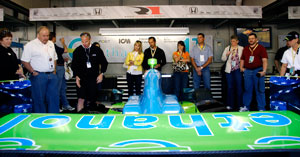 EPIC members got VIP access to the Team Ethanol garage today. As part of the pre-race festivities the Ethanol Promotion and Information Council sets up early morning tours for member reps. A special pass gives members privileged access and allows them to get an up close look at Team Ethanol’s two cars. Steve Wolf pointed out the defining features of the two IndyCars and described what it’s like to be behind the wheel.
EPIC members got VIP access to the Team Ethanol garage today. As part of the pre-race festivities the Ethanol Promotion and Information Council sets up early morning tours for member reps. A special pass gives members privileged access and allows them to get an up close look at Team Ethanol’s two cars. Steve Wolf pointed out the defining features of the two IndyCars and described what it’s like to be behind the wheel.
Wolf said this is the first year the IRL is using paddle shifting. Until last year, IndyCar drivers had to take one hand off the wheel in order to shift gears with a stick shift. Now, they can keep both hands on the wheel while they shift with a paddle on either side of the steering wheel.
IndyCar fuel tanks are smaller since the League switched to ethanol. Ethanol gets better mileage than the previous IRL fuel, methanol. Steve explained the League needed to make the tanks smaller so the fuel didn’t outlast the tires. The smaller tank, ultimately means less weight, allowing IndyCars to achieve higher top speeds.
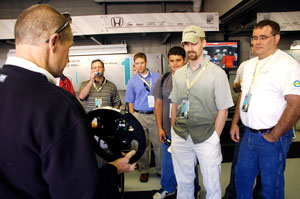 Steve says the pit window opens up about every 25 laps and he expects about eight to nine pits during this year’s Indy 500. Pit stops average between seven and nine seconds. Steve says the Team Ethanol pit crew is among the best in the League.
Steve says the pit window opens up about every 25 laps and he expects about eight to nine pits during this year’s Indy 500. Pit stops average between seven and nine seconds. Steve says the Team Ethanol pit crew is among the best in the League.
An IndyCar isn’t exaclty the most comfortable car out there to drive. Steve says the cockpit is a snug fit, with the IndyCar seat molded specifically for the driver. Ryan had to sit in the cockpit for three hours in order to get his customized seat, which Steve says is just a quarter inch thick at the bottom. Not much cushioning for a race that lasts a few hours!
Ryan will have no air conditioning in the cockpit. Steve explained the a/c was taking up too much horsepower so they had to lose it. An expected temp of 80 degrees during the race on Sunday means Team Ethanol expects it will be about 90 degrees on the track. When you consider to the fire jumpsuit Ryan will be wearing, you can imagine how hot it could get with no a/c. But, Wolf assures us that Ryan will have enough water to keep hydrated during the 200-lap race.


 If you think you’ve got a long drive this Memorial Day Weekend, check out what these travelers have ahead of them.
If you think you’ve got a long drive this Memorial Day Weekend, check out what these travelers have ahead of them.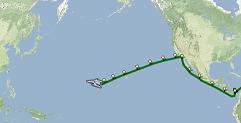 At 0400 GMT on Thursday the port engine high pressure fuel line began leaking at a joint. A bio-diesel mist filled the engine bay. Pete Bethune, the New Zealand skipper shut down the engine and Earthrace continued on the 2050 nautical mile leg with just one engine at 14-15 knots.
At 0400 GMT on Thursday the port engine high pressure fuel line began leaking at a joint. A bio-diesel mist filled the engine bay. Pete Bethune, the New Zealand skipper shut down the engine and Earthrace continued on the 2050 nautical mile leg with just one engine at 14-15 knots. The nation’s single largest biodiesel plant to date is set to open in early June.
The nation’s single largest biodiesel plant to date is set to open in early June. The National Biodiesel Board wants to remind Americans as they get on the road for the long, Memorial Day Weekend, that biofuels… biodiesel, in particular… are helping keep the price of a gallon of fuel from carving out an even larger portion of your wallet.
The National Biodiesel Board wants to remind Americans as they get on the road for the long, Memorial Day Weekend, that biofuels… biodiesel, in particular… are helping keep the price of a gallon of fuel from carving out an even larger portion of your wallet.

 One of the largest snack suppliers in the U.S. is also the supplier of ethanol fuel for the Indy Racing League. Yup,
One of the largest snack suppliers in the U.S. is also the supplier of ethanol fuel for the Indy Racing League. Yup, 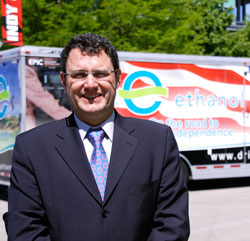 The discussion on ethanol should be about fuel plus food plus feed plus fibers plus fruits plus forests. At least, that’s what the president of UNICA thinks. Marco Jank spoke at yesterday’s Ethanol Summit and explained how ethanol has become not just a major fuel source in Brazil but also a stimulating proponent in many other industries, particularly food. Marcos adds that as technology continues to progress, the Brazilian ethanol industry will continue to grow. There’s no question. And, he says there’s no question that it will be the same for the U.S. In fact, he says the American ethanol industry is already growing at a faster rate than that of Brazil.
The discussion on ethanol should be about fuel plus food plus feed plus fibers plus fruits plus forests. At least, that’s what the president of UNICA thinks. Marco Jank spoke at yesterday’s Ethanol Summit and explained how ethanol has become not just a major fuel source in Brazil but also a stimulating proponent in many other industries, particularly food. Marcos adds that as technology continues to progress, the Brazilian ethanol industry will continue to grow. There’s no question. And, he says there’s no question that it will be the same for the U.S. In fact, he says the American ethanol industry is already growing at a faster rate than that of Brazil. The
The 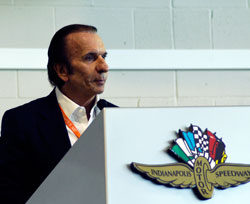 Many consider Emerson Fittipaldi, a two-time Indy 500 champ, “a true King of the Brickyard.” But not only is Emerson an IRL legend, he’s a BIG supporter of ethanol. Perhaps even a “King of Ethanol.” Emerson is a Brazilian ethanol producer and spoke at yesterday’s Ethanol Summit hosted by General Motors.
Many consider Emerson Fittipaldi, a two-time Indy 500 champ, “a true King of the Brickyard.” But not only is Emerson an IRL legend, he’s a BIG supporter of ethanol. Perhaps even a “King of Ethanol.” Emerson is a Brazilian ethanol producer and spoke at yesterday’s Ethanol Summit hosted by General Motors.